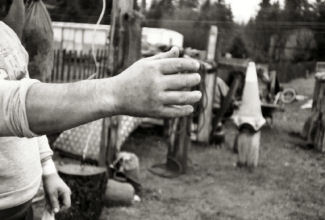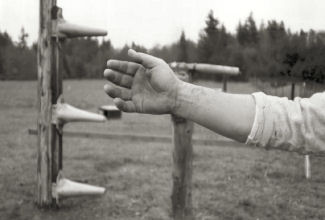
|
Chairs
Whenever Archie visited
local schools, questions inevitably got around to his
training methods. If he came without his usual array of
tools, and devices, Archie would of necessity
demonstrate using whatever was available. More often
than not, he would request some chairs. Once they were
brought to the floor, he would ride the wave of nothing
less than a flow of consciousness as to just how many
training techniques could be created using chairs as
platforms for body weight manipulation. These photographs were
taken at the school of Master David Bird, a well-known
Pacific Northwest Arnis pioneer and successor to the
late J. Cui Brocka. Some of Master Bird’s younger
students had questioned Sifu Archibeque on ways to
develop strength. Archie had the chairs brought out,
then began to improvise.
These first two
photographs are only a partial glimpse into what
occurred. Archie went to the ground, face down, and
reached forward with his right hand to grasp one of the
chair legs. Then, lifting the entire chair from the
ground from this awkward angle, he rolled like a log,
clockwise, all the while holding the chair off the
ground, until he rotated a complete circle, and was face
down on the ground once again. At that point, he lowered
the chair, grasped it in his left hand, then repeated
the process in the opposite direction. While not
impossible, the effect of this exercise is a slow and
gradual burn to the working muscles while the entire
body makes minute balance adjustments on the fly,
effectively turning this into a whole body workout.
These are generally
within the capabilities of trained athletes, and for the
most part, our group executed without difficulty. It was
only when Archie began doing the single hand variation,
followed by the one finger on each hand that the group
began drifting to the far perimeter walls of the dojo,
looking to be inconspicuous. Master Archibeque spent
years developing physical challenges which would enable
his students to switch Chi on or off virtually at will.
Most of these drills are built on the concept that your
body is put into an untenable stress position, which can
only be held if, using mental focus, you are able to
energize the body, stimulating its inherent capacity to
maintain integrity and protect itself. Again, think of this like
the fire hose on the roadway. When full of water, it is
energized , then becomes a solid, self-supporting
object. Even automobiles can pass over, without impeding
the flow of water to the hose. Archie then had the group
set the chairs apart, facing each other, separated by
approximately one body length. He dropped to the floor
and energized his body so that he became stiff as a
board, at which point we were instructed to lift him
onto the two chairs, his feet on one chair, his head on
the opposing chair. If you haven t done
something like this before, the bridge drill can be
quite imposing. Recognizing this, Master Archibeque
carefully belayed any fears, and within the hour,
virtually the entire group had been guided into
successfully performing this seemingly impossible
exercise.
Again, it is Archie’s
nature to leave you with an appropriate challenge, in
effect inspiring you to progress in your personal
training once he leaves. On this occasion, he returned
to his suspended position between the chairs, then began
doing full body gravity dips, allowing his neck and body
to loosen, dropping toward the ground, then
re-stiffening and returning to initial bridge position.
The photo speaks for itself. This is not for the timid!
Still inspired by the
moment, Archie mounted the chairs in a sideways
position, after reversing the lead chair and having a
student sit in the chair to hold it firm. Using his left
arm, he supported the weight of his body on the seat of
one chair, then set his bare right foot and ankle on the
back rest of the anchored chair. He then proceeded to do
body lifts, pumping up and down against gravity, with
what can only be described as an impossible stress load
on his arm and leg.
Archie returned to the two chairs, placing hands on the
seat of one chair, then the top of his feet (his
insteps) over the back of the anchor chair. He then
raised his entire body weight high toward the ceiling,
then reversed direction and lowered himself into a full
body dip. He repeated this process for some time until
the gasps of the group prompted him to give one of the
younger folks a try. After the group tried its luck, Master Archibeque
returned to the chairs, anchored both chairs with
volunteers, the chairs facing away from each other, and
began executing full body dips to the ground, with full
arm extension. To those who experienced Archie’s near
legendary strength, these extension exercises were of
profound importance (and long acquaintance). As I
recall, there were no takers when Archie asked for
volunteers to the exercise. Then, Jack Hyland, now a
master martial artist in his own right, but at that
time, a student, volunteered and did a very commendable
job as is evidenced in the photograph. As mentioned previously,
these photographs are only a smattering of what
occurred. Typically, I would be snapping pictures only
when brief opportunities allowed, and much of what
unfolded was never documented, except in our memories
and recollections. At the time, these photographs were
taken primarily for personal enjoyment. As participants
and students, we were too busy savoring the moment to
understand we were experiencing something profound and
unique, which, unfortunately has only been documented in
part.
Elastic
Media
Here, we again see
Archie’s preference to involve all class participants in
an exercise, whenever possible. Two of us are holding
the elastic, while the third (and sometimes even a
fourth) grips the elastic, then does a forward lordosis
full body dip toward the ground. All this is done while
constantly adjusting against the stretching and balance
challenging propensities of the elastic. After
completing the dip, the student then returns to starting
position. A typical routine would involve 10 up/down
cycles, then the three-way partnership would rotate to
the next person. Understand, the persons, standing and
holding the elastic are experiencing quite a significant
workout to their own arms and ligaments as the process
unfolds.
That was a very long
minute!
Archie found discarded
tires to be an excellent medium for developing wrist
strength. There were many exercises involving tires at
our training camp. Here you see Master Archibeque
showing how to effectively use the resistance of the
discarded tire to develop finger grip, wrist and forearm
strength, while developing the ligaments of the lower
arms. Other uses of tires have not been photographically
preserved. They would include throwing the tires for
distance; walking the length of the cow pasture dragging
tires with your feet; practicing stance movement
stepping through tires and on tires; using tires to
absorb falls, and even, in extremely rare instances,
using one to fix a flat on a car.
In the final shots, Master Archibeque is working at a station. Of particular note is the garage door spring attached to the top of the anchored tree section. Garage door springs were highly regarded items at Gun Fu camp, and they always found a home on one of our workstations where their afterlife continued post garage door, bringing additional years of profound discomfort to Archie’s many students.
Iron
Hand
Iron hand training takes
years of focus, determination, and discipline. There is
no shortcut, and the path involves pain, injury, and
recovery from injury, in a never-ending cycle. Even when
the objective is met, there will remain questions and
doubts as to whether the sacrifice was worth it. For
that reason, undertaking iron hand training is a
decision made only after considerable thought, and
assessment as to the benefits relative to the
sacrifices. Archibeque retained full
use of both hands, even after years of iron hand
training. He did have to sacrifice other interests, such
as playing musical instruments. Though he was never a
typist, the question is moot. The size of his hand, the
thickness of his digits, and the tendon tightness
resulting from iron hand training, would have prevented
him from ever using the keyboard beyond basic key
pecking.
Again, iron hand
training is always a very personal decision. If that
path is chosen, you may forever forsake other paths that
might otherwise be available in the martial arts. Most students of Gun Fu
trained diligently in breaking techniques, even though
they had chosen not to master iron hand. Other masters
within the Gun Fu system specialized in the internal
arts, and these included generation of power from
emptiness, rather than iron hand. Still others focused
on pressure point striking, ultimately taking it to the
highest level of poison hand (as an alternative of equal
merit to iron hand). In the net, every student was
capable of breaking rocks as part of training for Black
Belt. Every student at Black Belt level felt capable of
breaking bones or tearing flesh with virtually every
strike.
Archie once referred to
the iron hand as the atom bomb of martial arts. By that,
his meaning was clear. Whatever the situation, when the
iron hand is employed, destruction results. There is no
turning back. It is the highest of responsibilities.
Fortunately, training was so rigorous that students of
weak character or questionable merit were quickly rooted
out. As an aside, the training
regimen for iron hand is generally so intense and
demanding that typically, only one hand can be
completely developed over the course of time. Usually,
this is the dominant hand. In Master Archibeque’s case,
and my own, it was the right hand. It always concerned us
that some who came to class seemed completely obsessed
with the idea of iron hand training. Because of the
danger that could be done to oneself, and others,
Archibeque always looked for reasons not to train
someone in iron hand. One of the most frequently
occurring reasons, was rooted in a question repeated
many times over the years by students just beginning to
train. One or two weeks into training, these
questionable students would present to Master Archibeque
with the proposition they should also be training their
subdominant hand. They reasoned, since all the masters
were focusing on only one hand, they would be better
served training both. This of course, is the great
dilemma in life, and in the martial arts. Before you
master one thing, you are propelled by your belief that
more is better, adding an entirely new path before your
first journey has even begun. When a student questioned,
Archie simply replied, The iron hand is your atom bomb.
Puzzled by his response, they might come to me for
explanation. I would only add, The iron hand is your
atom bomb, why would anyone feel they needed two? |
[Home] [About Us
] [Archie] [Concepts] [Contact Us]
[Gun
Fu Manual] [Kata]
[Philosophy] [Sticks] [Stories] [Web
Store] [Terms of Use]
[Video]
Copyright 2000-2025, Mc Cabe and Associates, Tacoma, WA. All rights reserved. No part of this site can be used, published, copied or sold for any purpose, except as per Terms of Use .
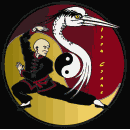
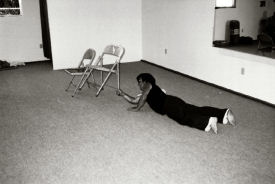
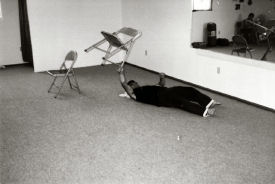
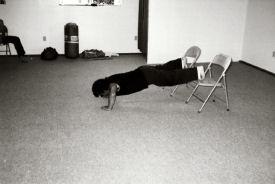 Next, Archie set both chairs in tandem,
then placed one foot on each chair. With feet on the
chairs, and hands on the ground, he executed push-ups.
Next, Archie set both chairs in tandem,
then placed one foot on each chair. With feet on the
chairs, and hands on the ground, he executed push-ups. 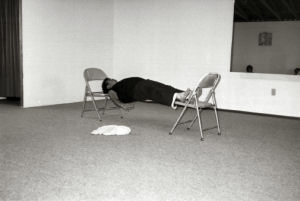
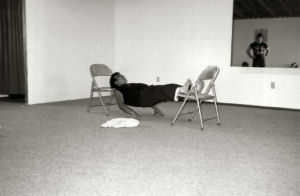

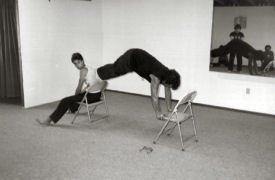
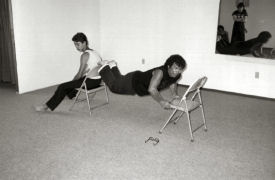

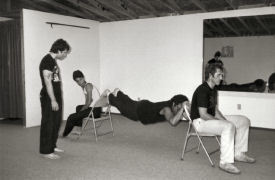
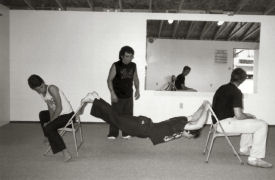
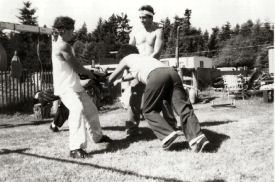 During his
years of active training, Master Archibeque was a major
fan of virtually all elastic media. Elastic media might
include any material capable of stretching and
rebounding. It might be old tires, inner tubes,
virtually anything capable of stretching, sustaining a
significant load, and returning to original shape
without degradation. Undoubtedly, Archibeque’s favorite
elastic training tool was a thick rubber tube used as a
washer (actually an O ring) in drainage basins, and
major water lines (as in city water mains). These tubes
would typically be made of a rubberlike material,
approximately 1 to 2 inches thick, circular in shape and
constructed in one piece. They came in loops, and sizes
varied widely, ranging
During his
years of active training, Master Archibeque was a major
fan of virtually all elastic media. Elastic media might
include any material capable of stretching and
rebounding. It might be old tires, inner tubes,
virtually anything capable of stretching, sustaining a
significant load, and returning to original shape
without degradation. Undoubtedly, Archibeque’s favorite
elastic training tool was a thick rubber tube used as a
washer (actually an O ring) in drainage basins, and
major water lines (as in city water mains). These tubes
would typically be made of a rubberlike material,
approximately 1 to 2 inches thick, circular in shape and
constructed in one piece. They came in loops, and sizes
varied widely, ranging 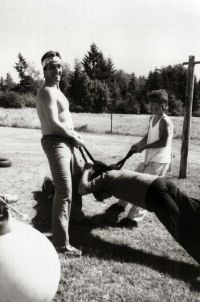 anywhere from 1-10 feet in diameter. As far
as we knew, they were indestructible. We never wore one
out, and did not know of one ever failing. Since Archie
worked on a road crew, these rings would become
available when an existing main was being revised and
the old rings were being discarded. For years, he would
stockpile these items of trash for eventual use in
training. They became for each of us, a valued tool.
Even today, I have several hanging in my garage, which
are used to assist my own students in their training.
anywhere from 1-10 feet in diameter. As far
as we knew, they were indestructible. We never wore one
out, and did not know of one ever failing. Since Archie
worked on a road crew, these rings would become
available when an existing main was being revised and
the old rings were being discarded. For years, he would
stockpile these items of trash for eventual use in
training. They became for each of us, a valued tool.
Even today, I have several hanging in my garage, which
are used to assist my own students in their training.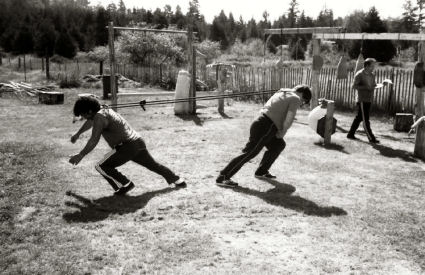

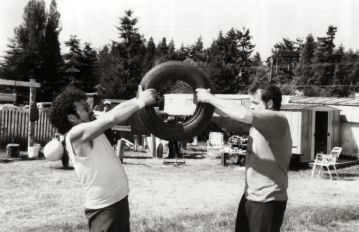
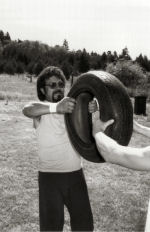
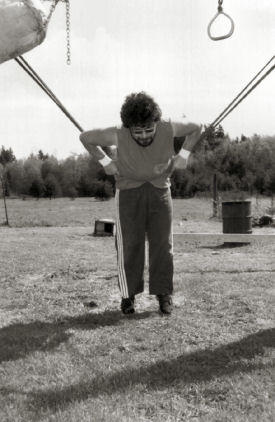
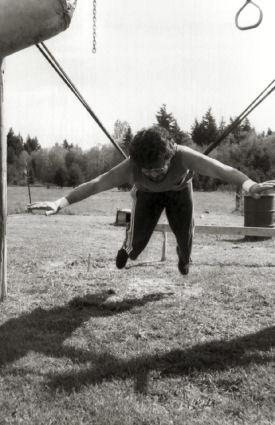
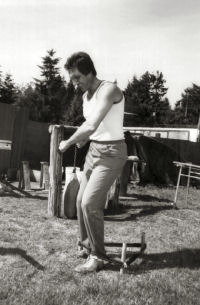
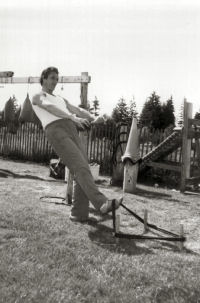
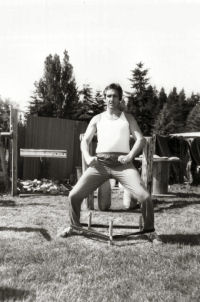
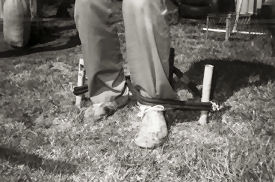 These simple
pictures show myself working one of the many stations
installed by Archieque in the cow pasture. These devices
typically have elastic rings mounted between anchored
PVC tubing, and I am using one elastic triangle to
develop strength and integrity in various stances and
foot positions while under stress. Deja vu! It s Shaolin
Temple all over again!
These simple
pictures show myself working one of the many stations
installed by Archieque in the cow pasture. These devices
typically have elastic rings mounted between anchored
PVC tubing, and I am using one elastic triangle to
develop strength and integrity in various stances and
foot positions while under stress. Deja vu! It s Shaolin
Temple all over again!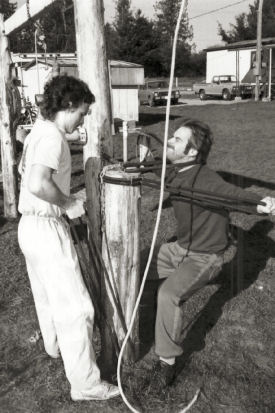 Archieque had many versions of training
dummies at the site. Typically, each dummy would be a
workstation, dedicated to a particlar aspect of training
and development. As you can see, a typical workstation
consisted of a tree trunk anchored in the ground, with
various mountings of elastic media used to develop
either hand, or foot techniques using principles of
resistance, and then resistance with movement, and then
resistance over periods of time. As you can see on some
of the stations, there can be multiple strands of
elastic. It is within the context of the exercise to use
both hands and arms, or any combinations of limbs and/or
body the user sees fit to engage at any point in time.
You were expected to be creative at all times while
working your conditioning.
Archieque had many versions of training
dummies at the site. Typically, each dummy would be a
workstation, dedicated to a particlar aspect of training
and development. As you can see, a typical workstation
consisted of a tree trunk anchored in the ground, with
various mountings of elastic media used to develop
either hand, or foot techniques using principles of
resistance, and then resistance with movement, and then
resistance over periods of time. As you can see on some
of the stations, there can be multiple strands of
elastic. It is within the context of the exercise to use
both hands and arms, or any combinations of limbs and/or
body the user sees fit to engage at any point in time.
You were expected to be creative at all times while
working your conditioning. 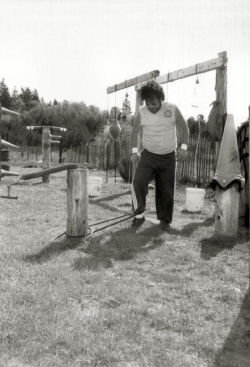

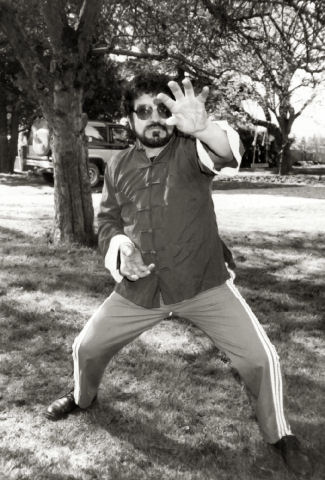 For many
students of gun Fu, iron hand training is at the core of
their practice. It was always a matter of personal
choice. Archie didn t encourage it, nor did he
discourage it. Whether or not you chose to master iron
hand, your were required to become proficient at
breaking as a self defense skill. While breaking and
training for breaking are discussed elsewhere in this
series of articles, and also on the website, I thought
it would be worthwhile to give you a direct glimpse of
Master Archibeque’s iron hand.
For many
students of gun Fu, iron hand training is at the core of
their practice. It was always a matter of personal
choice. Archie didn t encourage it, nor did he
discourage it. Whether or not you chose to master iron
hand, your were required to become proficient at
breaking as a self defense skill. While breaking and
training for breaking are discussed elsewhere in this
series of articles, and also on the website, I thought
it would be worthwhile to give you a direct glimpse of
Master Archibeque’s iron hand.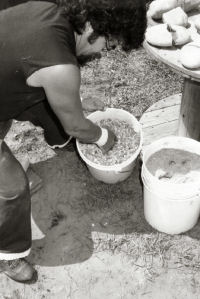 In the mature stage of his training, Archie
focused extensively on breaking. As we ve indicated
elsewhere, he preferred breaking rocks, since they were
readily available at no cost and provided genuine
challenge and opportunities for augmenting his
discipline. On occasions, he would do other things. For
example, there were 5 gallon buckets throughout the
camp, and some would be filled with sand, others with
rice, gravel, stones, or whatever other media of the
moment Archibeque was interested in working with. In the
above photos, you can see Master Archibeque working with
both a container of sand, and a container of pea gravel.
As we photograph, he struck the media with various
changing hand forms and shapes. Sometimes he punched
with a closed hand, sometimes he clawed like a tiger,
sometimes he stuck his fingers into the media with a
spear hand, sometimes he did fingers individually,
sometimes he would stick all five digits into the media
then turn his hand clockwise or counterclockwise, as if
turning a doorknob and sometimes (rarely) he would
experiment with changing the temperature of the media
(as in heating it).
In the mature stage of his training, Archie
focused extensively on breaking. As we ve indicated
elsewhere, he preferred breaking rocks, since they were
readily available at no cost and provided genuine
challenge and opportunities for augmenting his
discipline. On occasions, he would do other things. For
example, there were 5 gallon buckets throughout the
camp, and some would be filled with sand, others with
rice, gravel, stones, or whatever other media of the
moment Archibeque was interested in working with. In the
above photos, you can see Master Archibeque working with
both a container of sand, and a container of pea gravel.
As we photograph, he struck the media with various
changing hand forms and shapes. Sometimes he punched
with a closed hand, sometimes he clawed like a tiger,
sometimes he stuck his fingers into the media with a
spear hand, sometimes he did fingers individually,
sometimes he would stick all five digits into the media
then turn his hand clockwise or counterclockwise, as if
turning a doorknob and sometimes (rarely) he would
experiment with changing the temperature of the media
(as in heating it).